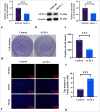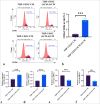A new perspective: Acyl-CoA synthetase long-chain family member 4 inhibits ubiquitin-specific protease 7-induced epithelial ovarian cancer progression by inducing ferroptosis and M1 macrophage polarization
- PMID: 40260070
- PMCID: PMC12010880
- DOI: 10.25259/Cytojournal_241_2024
A new perspective: Acyl-CoA synthetase long-chain family member 4 inhibits ubiquitin-specific protease 7-induced epithelial ovarian cancer progression by inducing ferroptosis and M1 macrophage polarization
Abstract
Objective: Epithelial ovarian cancer (EOC) is the most common and lethal type of ovarian cancer, and the cross-talk between tumor cell ferroptosis and macrophages is essential to cancer progression. This study aims to investigate the roles of ubiquitin-specific protease 7 (USP7) and acyl-CoA synthetase long-chain family member 4 (ACSL4) in the pathogenesis of EOC.
Material and methods: The expression patterns of USP7 and ACSL4 in EOC cell lines were first determined by quantitative reverse transcription polymerase chain reaction (qRT-PCR) and Western blot. ACSL4 recombinant protein was applied alone or in conjunction with a USP7 overexpression plasmid in EOC cells, and the effects of USP7 and ACSL4 on EOC cell proliferation and apoptosis were assessed using colony formation assays and terminal deoxynucleotidyl transferase deoxyuridine triphosphate (dUTP) nick end labeling staining. The effects of USP7 and ACSL4 on ferroptosis in EOC cells were evaluated by measuring reactive oxygen species (ROS) fluorescence intensity, malondialdehyde (MDA), glutathione (GSH) levels, and glutathione peroxidase 4 (GPX4) messenger RNA (mRNA) levels. Co-culture of EOC cell-conditioned medium treated with ACSL4 recombinant protein or USP7 overexpression plasmid was performed with Human Acute Monocytic Leukemia Cell Line (THP-1) macrophages, and the expression levels of cluster of differentiation 86 and cluster of differentiation 206 were analyzed by flow cytometry. The expression levels of M1 polarization markers and M2 markers in macrophages were measured by qRT-PCR.
Results: ACSL4 was expressed at low levels in the EOC cell lines, whereas USP7 was expressed at high levels. Treatment with ACSL4 recombinant protein reduced colony formation and increased apoptotic cell levels in the EOC cells (P < 0.001). In addition, ACSL4 treatment increased ROS fluorescence intensity and MDA levels while decreasing GSH levels and GPX4 expression (P < 0.001). Furthermore, ACSL4 treatment promoted the polarization of THP-1 macrophages toward M1, increasing the expression of M1 markers (P < 0.001). USP7 overexpression exerted the opposite effect (P < 0.001).
Conclusion: This study reveals the critical role of USP7 in the progression of EOC. ACSL4 inhibits EOC growth and anti-apoptosis by inhibiting USP7-induced antiferroptosis and anti-M1 macrophage polarization, highlighting this mechanism as a potential therapeutic target in EOC.
Keywords: Acyl-CoA synthetase long-chain family member 4; Epithelial ovarian cancer; Ferroptosis; Macrophage; Ubiquitin-specific protease 7.
© 2025 The Author(s). Published by Scientific Scholar.
Conflict of interest statement
The authors declare no conflict of interest.
Figures






Similar articles
-
VIPAS39 confers ferroptosis resistance in epithelial ovarian cancer through exporting ACSL4.EBioMedicine. 2025 Apr;114:105646. doi: 10.1016/j.ebiom.2025.105646. Epub 2025 Mar 14. EBioMedicine. 2025. PMID: 40088627 Free PMC article.
-
ACSL4 promotes ferroptosis and M1 macrophage polarization to regulate the tumorigenesis of nasopharyngeal carcinoma.Int Immunopharmacol. 2023 Sep;122:110629. doi: 10.1016/j.intimp.2023.110629. Epub 2023 Jul 13. Int Immunopharmacol. 2023. PMID: 37451020
-
[Alda-1 alleviates brain injury after cardiopulmonary resuscitation by regulating acyl-CoA synthetase long-chain family member 4/glutathione peroxidase 4 pathway-mediated ferroptosis in swine].Zhonghua Wei Zhong Bing Ji Jiu Yi Xue. 2023 Apr;35(4):376-380. doi: 10.3760/cma.j.cn121430-20220930-00871. Zhonghua Wei Zhong Bing Ji Jiu Yi Xue. 2023. PMID: 37308192 Chinese.
-
Astragaloside IV alleviates neuronal ferroptosis in ischemic stroke by regulating fat mass and obesity-associated-N6-methyladenosine-acyl-CoA synthetase long-chain family member 4 axis.J Neurochem. 2023 Jul;166(2):328-345. doi: 10.1111/jnc.15871. Epub 2023 Jun 9. J Neurochem. 2023. PMID: 37300304
-
Ferroptosis-targeting drugs in breast cancer.J Drug Target. 2025 Jan;33(1):42-59. doi: 10.1080/1061186X.2024.2399181. Epub 2024 Sep 5. J Drug Target. 2025. PMID: 39225187 Review.
References
LinkOut - more resources
Full Text Sources
Research Materials
